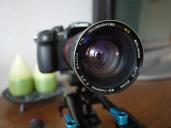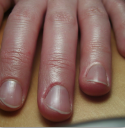
It allows to keep PV going, with more focus towards AI, but keeping be one of the few truly independent places.
-
I dropped my 77mm L.C.W Fader Mark II variable ND filter last night, shattering it. Bummer, but I had been meaning to replace it anyway. Why? Well, mainly bokeh striation. What is bokeh striation? I'm not exactly sure, but this is what it looks like:
(note the "scratchiness" inside the COCs, particularly in the brightest OOF areas). I do know that this is caused by the L.C.W variable ND filter. I don't know if other higher quality variable NDs cause similar issues, but I know that it's unacceptable for my work.So, I am looking at my options for neutral density, utilizing my recently-acquired Cinematics matte box. I have decided on Schneider optics as my brand, regardless of which type I buy.
The question I have is, does doubling up polarizers (one circular + one linear in the rotating tray, as a make-shift variable neutral density filter) cause any detriment to image quality, compared to a set of high quality ND filters? Specifically, will I risk bokeh striation as I did with the L.C.W Fader Mark II?
I really like the convenience of a variable ND filter. I can handle a slight loss of sharpness, or even a slightly (but only slightly) uneven distribution of ND filtering across the frame, but I cannot handle bokeh striation. It's so offensive to the eyes!
-
Genus are proud to announce the launch of the Solar Eclipse, a dual purpose filter comprising of a variable Neutral Density Filter AND a Circular Polariser. Both elements are individually adjustable to suit your shooting conditions and control the amount of light going through the lens.
Each of vari ND is also circular polarizer.
Do you mean that you can adjust both of polarizer filers separately or that?
-
Genus have brought out a new vari ND filter (I have their Genustech Eclipse, which is better than the Tiffen vari nd which I also own). Looks like the first vari ND to properly incorporate a polarising filter as well.
-
And don't forget that all variable NDs soften image (a lot!) when used on telephoto lenses. Starting from around 100mm focal length and over.
-
If you think nd filters do not change anything with color cast you need to do more homework!!!
notice at the end of that video they used two polarizers and had no color shift. Not only do nd filter cause color shifts different sensors react differently to each nd filter. http://nofilmschool.com/2012/12/choosing-neutral-density-filters-infrared/ You should know what you are talking about before you go blasting away on a forum -
@feha Oh I wasn't referring to you at all! But I'd still love to see some tests with the ND on your lens at 50 and above. You can still tell if it softens your lens up more.
-
@vicharris , i did not had time to test Eclipse Vari ND from Genus with vintage zoom lens, as I'm missing a step up ring 72 - 77 mm, have an old Soligor 35-140 f3.5 not that sharp lens ... Have no other zoom lens at present time ...

 P1000720.JPG4000 x 3000 - 5M
P1000720.JPG4000 x 3000 - 5M -
As stated many times, the Genus is the same quality as LCW one. You need to look at the Genus Eclipse. Two very different filters. Seems like this.test was done to make the Genus fail on purpose.
-
Best review I've seen comparing crappy Genustech Vari ND with others:
A generalization - seems like so many people obsess over purchasing the sharpest lens possible and then put a crappy ND in front of it.
-
Couldn't help but notice all the polarizing or not on VND's. I've used a set of hoya/canon polarizers to make a vnd and yes you could rotate both together after adjusting the exposure and see the polarizing effect. However I now use a 72mm Opteka vnd that cost $30 on amazon and there is no polarizing effects. Also, never seen any bokeh quality, overall sharpness or ghosting even in stills.
-
@QuickHitRecord Thank you, that's very informative, and frankly a bit startling. I never noticed such dramatic polarizing effects with my own L.C.W Fader ND. I actually find some polarization of water, particularly moving water, aesthetically pleasing. I wonder if the Fader NDs use 2x circular polarizers, or 1 circular and 1 linear. Now that mine is broken, maybe I'll try pulling it apart and doing some tests with it.
-
Yep, that's what we're saying! Thanks.
Those reflections in water are essential in that shot.
The earlier still shots of hands? The importance of reflectivity is less obvious under certain circumstances. But the principles of studio lighting demand reflection off eyes, hair and clothes' sheen (for back lighting).
FWIW, they say Louis Armstrong never really had a perspiration problem. They sprayed him with water before each take to bring out his skin texture. He played along.

Lighting/filming dark faces is a whole other rule-book. It's what I do most and it still poses problems. These days, I am extra respectful of people's sensitivity when I mention skin colour.
With polarisation testing: It's so easy to do ,why not do the test anyway instead of googling? (Unless you're generation-Z, in which case put in on your bucket-list of real life experiences) ;-)
-
@goanna Not exactly what you're looking for, but take a look:
-
@Sangye: If somebody wants super shallow DoF I can see that, but what I do then is to slap on a longer lens. Naturally shallow and it adds a lot of other nice effects. Plus in exteriors distance isn't an issue...
But I would recommend getting a regular ND (I use a 1.2, as the GH2 is very sensitive to highlights) in 4x4 and then a Vari nd as a screw on. And it has A LOT of polarising effect. We shot with one on an Epic and as soon as it was on, I saw the sky drop, not from the ND, but from the pola...
-
Yes, good 4" filters are so expensive it's a really sensible idea to experiment with rented or borrowed ones first.
if you read my DOF post carefully, I'm not lecturing anybody Using shallow DOF when that's what you get with your focal length or for the mood you need to convey is essential. Whan it's done gratuitously it looks wrong. I'm not the only one to notice and already seeing it satirised on TV comedy sketches.
I'd be interested to see any real tests stills of a reflective surface using a variable ND filter : see if you can reproduce reflections correctly, then see if you can manage to cut them. Often simple polarising depends on the sun's angle in the sky.Wearing my polaroid sunglasses while driving, I can cut the road's shiny reflection by tilting my head to one side.
-
Also, I'm not concerned about the polarizing effects of stacking polarizing filters. VNDs are built this way, and they do not polarize an image in the same way that a single polarizing filter does, nor in a way that I have ever found problematic, bokeh striations notwithstanding. From what I understand, when two circular polarizing filters are used together with one in reverse, the second polarizer effectively "de-polarizes" the image. This is consistent with what I've read elsewhere, and explains why brands like Singh-Ray sell polarizing as well as non-polarizing VNDs. One uses two circular polarizers, while the other uses one linear and one circular polarizer.
The only thing that has been posted so far that gives me pause, is VKs point about minimizing air-glass surfaces, and that effects aside, polarizing glass negatively impacts IQ more than neutral density glass. I'll probably borrow some circular polarizing as well as ND filters from a friend and experiment with this, and then make a decision.
-
Thanks for the responses. @goanna I agree that that the shallow-DOF look is increasingly associated with amateur filmmakers who compulsively throw every background out of focus. I shoot lots of stuff, and a lot of it has deep focus. However, there are moments when shallow DOF is important. I need control. I need to be able to shoot razor-thin DOF when the situation, or a client, calls for it. That is why I have a f/0.95 lens, and why I want corresponding ND filters. I don't need you to lecture me on the impact of shallow DOF. I am aware.
-
@Sangye Here's the thing (and this applies to the 4x4 linear and circular polarizer approach as well): You don't necessarily want to polarize every shot, which is what you will be doing to some degree by always having a polarizer in front of your lens. If you rotate a fader filter in the screw threads on the front of your lens while shooting a reflective surface, you'll notice the shift -- and if you screw the filter on tight to keep it from falling off your lens, you really have no control on the orientation and thus polarizing properties of the rear filter element.
As @goanna says, this defeats the "neutral" purpose of neutral density. Sure, it's great to bring out the sky on landscape and wide shots but there is a reason why DPs tend not to polarize their human subjects. It literally cuts the subtle skin reflection that most of us don't even notice until we get to post. Then skin looks very flat. I offer the attached examples. They are a bit extreme but you should get the idea.

 Screen shot 2012-10-04 at 9.42.29 AM.png636 x 414 - 273K
Screen shot 2012-10-04 at 9.42.29 AM.png636 x 414 - 273K
 Screen shot 2012-10-04 at 9.42.38 AM.png638 x 652 - 513K
Screen shot 2012-10-04 at 9.42.38 AM.png638 x 652 - 513K -
It's not that. Heck, I tend to not have the biggest DoF either. For me though it's because of my lens choices. I like long lenses, my current favorite being my Lomo 150! The reason is it's amazing separation and compression. Everything I see through it takes on a beautiful look.
What I think of is how many people use very wide lenses for a shallow DoF. Outside, that's never a problem.
And if you want that, get an IR ND at possibly a 1.8 and then a 1.2 regular ND and stack...
-
And again, f/0.95 in daylight? Why?
As I read this, I was watching a series of local TV ads, a couple not so good but with wide lens/aperture shallow DOF combinations - yet, the talent in the ads were in front of sports grounds and open countryside.
more like, "Shallow DOF? Why?" Just why do you want to isolate a footballer from the football ground? Is it so show his feelings of solitude? Is the POV from binoculars? In whose time is the shot?
In these ads, it was clear that the videographer had no idea or any purpose.
A much -desired shallow DOF look has suddenly become uncool for me. Overdone, soo 2012. Already, as of 4th October 2012 I'm over the gratuitous, inappropriate shallow DOF.
-
@Sangye: The reason films rarely use variable NDs is that it's not a proper ND as goanna says. It's two polarisers who when rotated makes the frame darker. Which means you will have a very strong polarising effect. Plus it takes away a very important aspect of an ND: Neutral. The filter is no longer neutral, it has an effect on the picture, while a good ND does almost nothing with the frame.
And again, f/0.95 in daylight? Why?
-
If this online DSLR light calculator seems to be of any help, please tell me how you did it:
-
@Saynge f/0.95 !! Maybe a 0.9 if you're on a beach, snow. But get one anyway. Imagine that shallow DOF!
a 0.6 opens up 2 stops a 0.9 opens up 3 stops
-
Plus, the matte box looks seriously cool with that expanse of glass in front. You look even cooler swapping filters. :-)
-
@goanna if I go with fixed ND filters, would you say that for bright outdoor shots on a f/0.95 lens, ND 0.6 is sufficient without going crazy on the shutter speed (I like to keep it slower than 1/100)? Could a 0.9 be used without going crazy on ISO (keeping it under 1250)?
Howdy, Stranger!
It looks like you're new here. If you want to get involved, click one of these buttons!
Categories
- Topics List23,911
- Blog5,718
- General and News1,330
- Hacks and Patches1,148
- ↳ Top Settings33
- ↳ Beginners254
- ↳ Archives402
- ↳ Hacks News and Development56
- Cameras2,342
- ↳ Panasonic984
- ↳ Canon118
- ↳ Sony154
- ↳ Nikon95
- ↳ Pentax and Samsung70
- ↳ Olympus and Fujifilm98
- ↳ Compacts and Camcorders295
- ↳ Smartphones for video96
- ↳ Pro Video Cameras191
- ↳ BlackMagic and other raw cameras116
- Skill1,959
- ↳ Business and distribution66
- ↳ Preparation, scripts and legal38
- ↳ Art149
- ↳ Import, Convert, Exporting291
- ↳ Editors190
- ↳ Effects and stunts115
- ↳ Color grading197
- ↳ Sound and Music280
- ↳ Lighting96
- ↳ Software and storage tips266
- Gear5,407
- ↳ Filters, Adapters, Matte boxes344
- ↳ Lenses1,577
- ↳ Follow focus and gears93
- ↳ Sound496
- ↳ Lighting gear313
- ↳ Camera movement230
- ↳ Gimbals and copters302
- ↳ Rigs and related stuff271
- ↳ Power solutions83
- ↳ Monitors and viewfinders339
- ↳ Tripods and fluid heads139
- ↳ Storage286
- ↳ Computers and studio gear559
- ↳ VR and 3D248
- Showcase1,859
- Marketplace2,834
- Offtopic1,314











